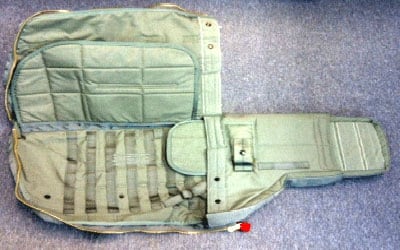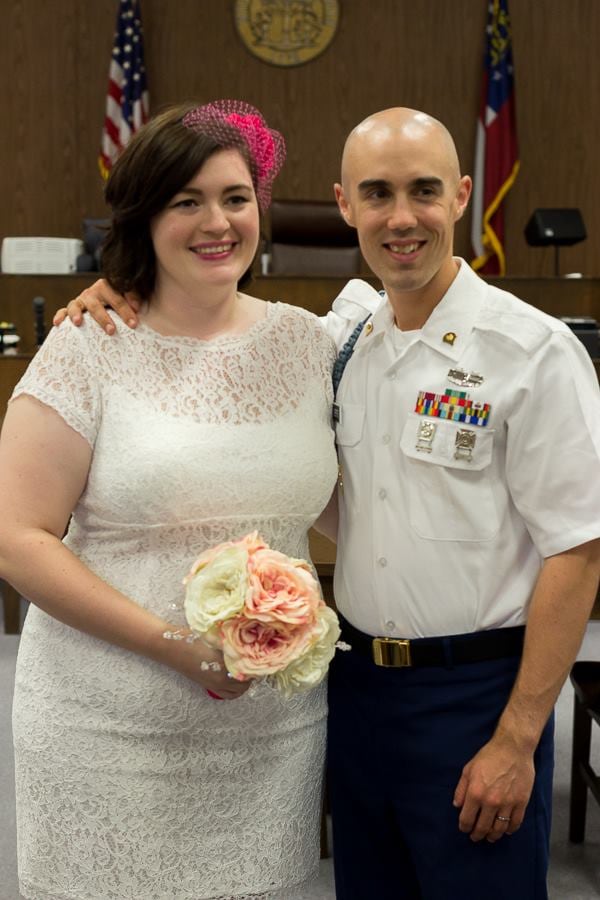This story was originally published on March 5, 2016. It has been updated to include findings from a second investigation.
An Army investigation into a paratrooper's death last spring determined the soldier's improper exit from the plane caused his death.
Roberts, 27, was killed instantly when the static line cut his neck as it became taut during his initial fall, according to the 15-6 report.
The accident occurred April 28, during a night jump into Sicily Drop Zone at Fort Bragg, North Carolina. It was Roberts' seventh jump, but his first at night with a loaded rucksack and MAWC. His inexperience was cited as a contributing factor to the accident. But the report also cited poor performance by jumpmasters, who failed to attend a pre-jump training. The jumpmasters were formally admonished and received letters of reprimand.
Roberts, a member of 3rd Brigade, 82nd Airborne Division, joined active duty and reclassified to infantryman in 2014 after roughly four years in the Reserve, which included a deployment to Afghanistan as a military police officer in 2011-12.
"He liked a good challenge," his mother, Kathy, told Army Times. "He wanted to make a difference, on a bigger scale. He wanted to help people. He thought maybe he could work his way into a position where he could be a good leader."
Roberts had been married for less than a year. His wife, Whitney, also said "he would help anyone."
"I can't believe he's not here. Surreal is the best word for it," she said. "He was just one of those people who would have been a great career soldier."
Roberts' death came 12 days after the death of Pvt. Josh Phillips, from the 82nd's 2nd Brigade. Phillips, also on his seventh jump, died at Fort Polk, Louisiana. Phillips was determined to have died after a loose rucksack from another jumper ripped a hole in his parachute. He did not activate his reserve as he fell too fast during the night jump in adverse weather.
In Roberts' case, video and witnesses indicated that his MAWC was rigged too loosely. As he handed off his static line just before jumping from the aircraft, "his MAWC was positioned at an improper angle and appears nearly horizontal, as he turned in to the paratroop door," according to the report. The jumper behind him testified that Roberts spun on his way out.

An investigation concluded that Spc. Nicholas Roberts improperly exited the C-17 when his Modular Airborne Weapons Case, used to carry a rifle and other items during an airborne jump, hit the airplane door.
Photo Credit: PEO Soldier
"I observed Roberts rotating on the jump platform to his left. He ended up exiting backwards, facing towards me in the door," said the soldier, whose name was redacted in the report.
The investigation concluded that, as Roberts fell, the static line came into contact with his neck and killed him when it pulled taut. (The static line, attached to the inside of the plane, follows the jumper out of the plane and pulls open the parachute pack when the soldier is clear of the plane.)
Roberts' parachute opened normally, and he floated to the ground, the investigation found. No one knew a fatal accident had occurred until the tactical teams had gathered on the ground. Roberts was determined missing at around midnight, roughly 90 minutes after the jump, and 20 minutes later a search party found him.
Whitney Roberts said her husband had recently scored well on an aptitude test to enter psychological operations, and he was working toward a shift into that special operations MOS. Things were "falling into place for us," she said. Instead: "It's pretty much been a nightmare."

Spc. Nicholas Roberts married his wife, Whitney, just under a year before his fatal jump on April 28, 2015.
Photo Credit: Courtesy of Whitney Roberts
She had never seen her husband jump before, but the night of the fatal jump she happened to have some spare time. So on a whim she drove to the drop zone to watch, even though it was so dark she couldn't really see anything. She figured she was the only civilian there.
She heard the planes fly overhead, but since it was a tactical exercise that would keep him busy all night she went home, thinking nothing was wrong. She didn't hear from him before going to sleep, but she knew he wasn't one to pull his phone out when he wasn't supposed to. Though her night ended without concern, she knew something was wrong in the morning when she had no messages or calls from her husband.
"I had a horrible feeling in the pit of my stomach," she said. "Obviously when your husband is in the military, you don't expect them to knock on your door when your husband's 10 miles away."
Whitney Roberts said the reports' implication her husband made a mistake has been hard to accept, given what she knows of his attention to detail.
"He wasn't one to say, 'no, that's fine,'...He was extremely professional" she said of his tendency to follow the rules. "That's why it was hard for anybody to believe he would make a mistake."
She described him as intelligent with a dry sense of humor. In the investigation, a witness said they shared a couple of "chuckles" during their interaction that evening. Roberts was a man of relatively few words, his wife said, but when he spoke they were powerful. She said she and friends ribbed him for being "and old man" and called him "very wise."
Away from the Army, she said he had an artistic side: He sang and played guitar. She has set up a GoFundMe page to establish a music scholarship in Nicholas' name at his high school.
Rigging and jumpmasters
Townsend, after signing off on the 15-6 investigation June 4, was briefed June 30 on a separate CRC investigation. Those findings led to a follow-up memo concerning the 15-6.
"It is inconclusive whether Spc. Roberts MAWC made contact with the lead edge of the paratroop door or whether his MOLLE [Modular Lightweight Load-carrying Equipment] struck the trail edge," wrote Townsend in a July 28 memorandum for the record.
An official source with knowledge of the investigation, who spoke to Army Times on condition of anonymity, said CRC concluded the MOLLE caused the spin. A cellphone video, the source said, was obstructed at the time of Roberts' jump and inconclusive; it's part of the reason mounted GoPro cameras now capture every jump.
Whether the MOLLE or the MAWC caused Roberts' turn, it was determined that the rigging on his MAWC was improper. According to the 15-6, upper tie-down tape wasn't routed from bottom to top, as it should have been. The adjusting strap was not secured with excess stowed, and it had 4 inches of slack rather than the maximum of 1 inch. And while the leg strap was on, it was not tightened prior to exit per standard procedure. (The investigation noted it's common for soldiers to walk around with the leg strap loose for comfort, but that it's supposed to be tightened when soldiers stand up to leave the aircraft.)
The entire jumpmaster team received General Officer Memorandums of Reprimand, according to 82nd spokesman Master Sgt. Patrick Malone. Malone could not comment on the XVIII Corps investigation, but said there are multiple occasions during jumps where gear is inspected for safety. The Jumpmaster Personnel Inspection, which includes inspection of the attachment of the weapons case rigging, is where most issues are discovered and corrected, according to Malone. There are also buddy checks in flight , as well as a final check by a safety officer, though the primary focus of that last check is to ensure that the static line is correctly routed and linked to the anchor cable in the plane.
The investigation found that the entire jumpmaster team failed to attend the "donning class," (pre-jump training on properly putting on the parachute), as policy dictates. Instead they were at a meeting with the jump's airborne commander at that officer's request while the departure airfield control officer conducted it in their absence. None of the jumpmasters raised concerns over missing the donning briefing.
Witnesses said Roberts was the soldier used in the demonstration at the donning class, and that his MAWC was hanging loose then as well. The investigation includes conflicting accounts from soldiers as to the status of Roberts' MAWC rigging and how or whether it was corrected at various subsequent points pre-jump.
Following the pre-jump training, a soldier whose name was redacted asked if anyone needed further training on rigging the MAWC; several paratroopers raised their hands and a fit-and-wear class on the MAWC was conducted. Roberts did not attend the MAWC rigging class. The report said Roberts' JMPI discovered no problems with his equipment or parachute.
After the deaths of Roberts and Phillips, XVIII Airborne Corps temporarily suspended all airborne operations. It also adopted 15 directives in response to the deaths, including changes to the progression of a new airborne soldier. After airborne school, paratroopers should first conduct a daytime jump with combat gear; followed by night jump with combat gear; and conclude with a mass tactical jump (which Roberts' jump was). A soldier should not move on to the next stage unless his leaders deem him ready.
Other directives stemming from the response to the incident, according to a "Notification of Compliance" provided to Army Times, include:
- Brig. Gen. Brian Winski, deputy commander of the 82nd Airborne Division, "formally admonished" the jumpmaster team.
- Retrain jumpmasters Airborne-wide, emphasize exit and MAWC rigging, and specifically refresh the jumpmasters from April 28 on MAWC rigging.
- Emphasize the "duties and importance of the Airborne Commander."
- Review and consider documentation processes of Jumpmaster Personnel Inspection and graded performance checks of equipment.
- Emphasize gaining accountability for all soldiers before releasing anyone from the drop zone (malfunction officer was released prior to full accountability and had to be called back.)




